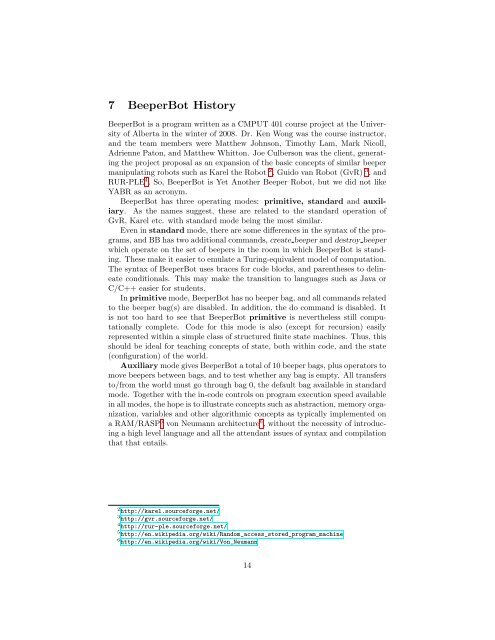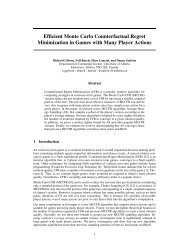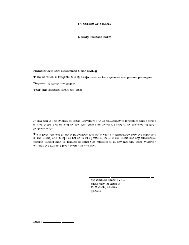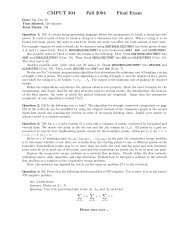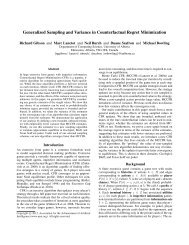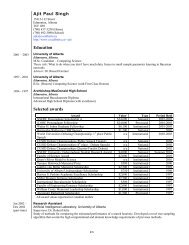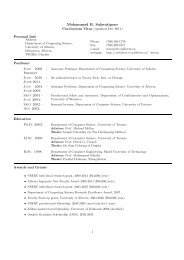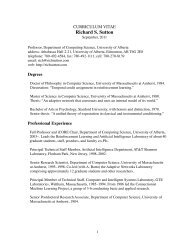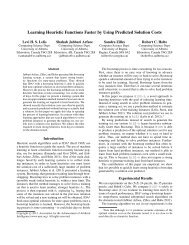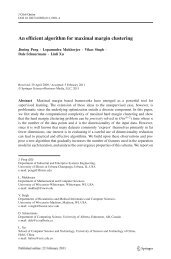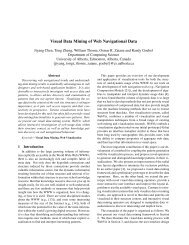BeeperBot Manual - Department of Computing Science
BeeperBot Manual - Department of Computing Science
BeeperBot Manual - Department of Computing Science
- No tags were found...
You also want an ePaper? Increase the reach of your titles
YUMPU automatically turns print PDFs into web optimized ePapers that Google loves.
7 <strong>BeeperBot</strong> History<strong>BeeperBot</strong> is a program written as a CMPUT 401 course project at the University<strong>of</strong> Alberta in the winter <strong>of</strong> 2008. Dr. Ken Wong was the course instructor,and the team members were Matthew Johnson, Timothy Lam, Mark Nicoll,Adrienne Paton, and Matthew Whitton. Joe Culberson was the client, generatingthe project proposal as an expansion <strong>of</strong> the basic concepts <strong>of</strong> similar beepermanipulating robots such as Karel the Robot 2 , Guido van Robot (GvR) 3 , andRUR-PLE 4 . So, <strong>BeeperBot</strong> is Yet Another Beeper Robot, but we did not likeYABR as an acronym.<strong>BeeperBot</strong> has three operating modes: primitive, standard and auxiliary.As the names suggest, these are related to the standard operation <strong>of</strong>GvR, Karel etc. with standard mode being the most similar.Even in standard mode, there are some differences in the syntax <strong>of</strong> the programs,and BB has two additional commands, create beeper and destroy beeperwhich operate on the set <strong>of</strong> beepers in the room in which <strong>BeeperBot</strong> is standing.These make it easier to emulate a Turing-equivalent model <strong>of</strong> computation.The syntax <strong>of</strong> <strong>BeeperBot</strong> uses braces for code blocks, and parentheses to delineateconditionals. This may make the transition to languages such as Java orC/C++ easier for students.In primitive mode, <strong>BeeperBot</strong> has no beeper bag, and all commands relatedto the beeper bag(s) are disabled. In addition, the do command is disabled. Itis not too hard to see that <strong>BeeperBot</strong> primitive is nevertheless still computationallycomplete. Code for this mode is also (except for recursion) easilyrepresented within a simple class <strong>of</strong> structured finite state machines. Thus, thisshould be ideal for teaching concepts <strong>of</strong> state, both within code, and the state(configuration) <strong>of</strong> the world.Auxiliary mode gives <strong>BeeperBot</strong> a total <strong>of</strong> 10 beeper bags, plus operators tomove beepers between bags, and to test whether any bag is empty. All transfersto/from the world must go through bag 0, the default bag available in standardmode. Together with the in-code controls on program execution speed availablein all modes, the hope is to illustrate concepts such as abstraction, memory organization,variables and other algorithmic concepts as typically implemented ona RAM/RASP 5 von Neumann architecture 6 , without the necessity <strong>of</strong> introducinga high level language and all the attendant issues <strong>of</strong> syntax and compilationthat that entails.2 http://karel.sourceforge.net/3 http://gvr.sourceforge.net/4 http://rur-ple.sourceforge.net/5 http://en.wikipedia.org/wiki/Random_access_stored_program_machine6 http://en.wikipedia.org/wiki/Von_Neumann14


